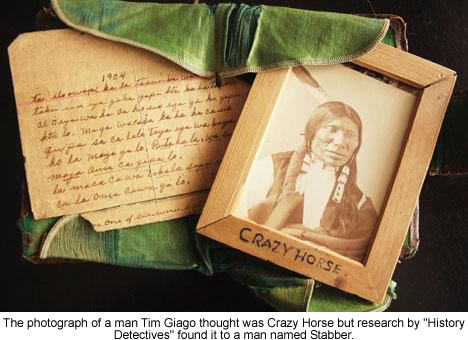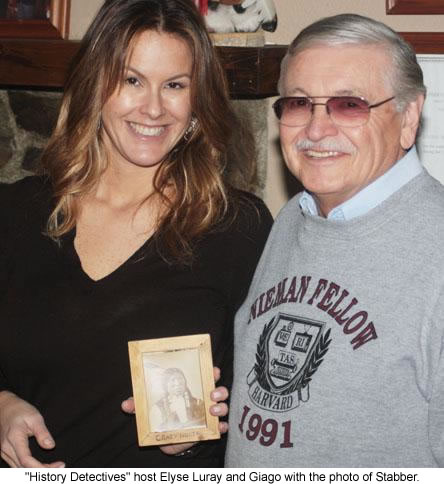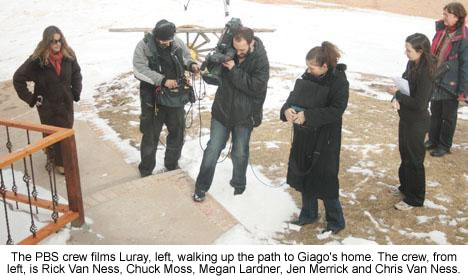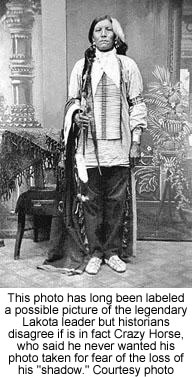 |
Canku Ota
|
 |
|
(Many Paths)
|
||
|
An Online Newsletter
Celebrating Native America
|
||
|
March 1, 2009 - Volume
7 Number 3
|
||
|
|
||
|
In Search Of Crazy
Horse
|
||
|
by Tom Lawrence - The
Rapid City Weekly News
|
||
|
credits: Photos by Andy
Jacobs
|
|
Crazy
Horse not subject of photo, research proves 1872 photo really shows
Stabber, who attended Washington peace talks.
Researchers from a PBS show who study historical mysteries have determined that a photograph believed to be the only one of the legendary Lakota leader is in fact that of another man, Giago said. He has owned the photo for more than a quarter century and in recent months decided to learn the truth behind the image. The photo is of a Lakota man named Stabber, Giago said. The PBS researchers revealed that to him before they returned to New York City last week. Giago said while he's disappointed in a way, in another way it's fitting that the photo is not Crazy Horse. "Maybe all the legends that he never had a photo taken are true," he said.
Alex Gardner, whose studio was at 921 Pennsylvania Ave., took the photos. A "History Detectives" staffer found the original glass negative of the photo in capital archives and learned that it was a picture of Stabber, not Crazy Horse, who never went to Washington. Crazy Horse and Red Cloud didn't get along at all, according to Giago, so it's no surprise he wasn't there for the peace talks. The researcher learned the names of all 25 delegates, Giago said, so the photo did lead to an important addition to Lakota history. Efforts to create a lasting peace between invading whites and Native Americans collapsed in 1874 when the Custer Expedition confirmed there was gold in the Black Hills, which led to the illegal invasion of Paha Sapa, the Native sacred soil. Within two years, on June 25, 1876, Custer and more than 250 of his men were wiped out in the Battle of the Little Bighorn. Crazy Horse was one of the leaders of the Indians who defeated the 7th Calvary that day. A gift from an admirer
A man he recalls only as Mr. Evans stopped by to see him. Evans was an admirer of the paper and Giago and had a gift for him. It was a very old leather pouch, tied with leather strings and lined with green velvet, Giago said. Two items were inside: an old-fashioned wood-framed picture with the words Crazy Horse written beneath it and a letter, dated 1904, written in Lakota. The letter, signed by Ben Black Elk, said the photograph was one of his "good friend Crazy Horse." Evans told Giago that a Native American employee of his at a construction company needed money and had pawned the items. Evans paid to recover them when the worker said they were important relics, Giago was told.
In 2008, Giago, who turns 75 this year, decided he should have the picture and letter investigated. Donovin Sprague, who works at Crazy Horse Memorial, examined it and asked Giago why he had kept it hidden away for so many years. "I was busy with a whole lot other things," Giago said. Now he's retired and has more time on his hands. He decided to have the photo checked out. At least the Lakota people should know about it, Giago reasoned. Sprague is an enrolled Minnicoujou Lakota and adjunct instructor in undergraduate and graduate studies for Black Hills State University in American Indian studies, political science, education, history and art. He knew people at "History Detectives" so he asked them to do the research. Last fall, the items were sent to them, Giago said. "They said they would treat it like gold," he said. Giago hoped the photo was authentic. "I think it is," he said last week. "Because of the letter that came with it." It was written in "very old Lakota, ancient Lakota," he said.
Beard was a witness to and survivor of Little Bighorn and Wounded Knee. "That's what threw me off, that his name was on it," Giago said. After 27 years while the photo, letter and satchel remained locked away, a mystery was waiting to be solved. If was a real image of Crazy Horse, Giago wanted it placed somewhere people, especially Lakota people, could view it. He also admitted to wondering how much it was worth. The myth and the man Crazy Horse was and still is a hero among the Lakota people, Giago said. His heroic feats on the battlefield, leadership skills and murder on Sept. 5, 1877, created an enduring myth around a very real man. Other Lakota leaders don't quite measure up, he said. "Sitting Bull's sort of added a little gray to his name when he joined Buffalo Bill Cody's Wild West Show," Giago said. "Crazy Horse never put his name on a treaty, maintained his freedom for his own people until the day he came in and surrendered at Fort Robinson." It's fitting that this latest effort to learn more about Crazy Horse came in a trip to his homeland. According to numerous reports and interviews with people who knew him, Crazy Horse was born about 1840 on the banks of what is now called Rapid Creek. His birth name was "In The Wilderness" or "Among the Trees." He grew to become an accomplished horseman, hunter and warrior. Some accounts said he was relatively fair-skinned with light-colored hair. Giago disputes that and said that came from Mari Sandoz's 1942 book on Crazy Horse. The photo Giago had was of a "pure, full-blood Indian," he said, and he believes that's what Crazy Horse looked like. While "Curly" was his nickname, Giago said Crazy Horse once rode a horse whose mane was tangled and curly, which led to the nickname. The name Crazy Horse is often misinterpreted by people unfamiliar with Lakota. "It's sort of wild horse rather than crazy," he said. Giago's not a fan of the Crazy Horse Memorial, which he calls "a disgrace." He feels carving a mountain in the sacred Black Hills is an inappropriate way to honor a Lakota legend. Giago said he told Ruth Ziolkowski, the matriarch of the Crazy Horse Memorial, years ago that he had a photo that might be Crazy Horse and she declined to see it. He said the face on the mountain bothers him. "I think it's certainly not (Crazy Horse) -- it's a generic Indian," Giago said. "Why give it the name of one of the famous Lakota warriors?" Taping the show The "History Detectives" team is Elyse Luray, Wes Cowan, Tukufu Zuberi, and Gwen Wright. Megan Lardner is the show's director and producer. On Jan. 29, the "History Detectives" crew arrived at Giago's house in two vehicles. Luray drove a mini van that Lardner and the show's director of photography, Chuck Moss, filmed winding down Giago's driveway. The crew shot much of the show's footage multiple times. Lardner said various takes will help slowly reveal the truth about Giago's photo. "We like to show a story that tells a bigger story," Luray said. "We like to show people how they're connected to American history and this was a good chance to tell the story of the Lakota Indians and Crazy Horse." Luray has been with the show for seven years. She has an art history background and worked for "Antiques Roadshow" on PBS before joining "History Detectives." "The story starts here [in South Dakota] and ends, with his death in a different spot," she said. Many historical mysteries don't make it on the show, Luray said. Researching and authenticating artifacts can take a long time. "It depends on what it is and how accessible archives and libraries and historical societies are," she said. Researching an artifact can take from six weeks to a full year. Most of the filming took place in Giago's study. Filled with sound equipment and bright lights, the room in the house on the edge of Rapid City was crowded. The crew, two local sound technicians, a director of photography, an associate producer, the show's host, Giago and the director all worked in the close quarters. No loud cries of "Cut" or "Action" were heard and all of the direction from Lardner was positive and polite. The crew filmed scenes interviewing Giago and then asked him to change clothes. They then staged a second scene, supposedly much later, in which they met with a second time to tell him the man in the photo was not Crazy Horse. The crew also filmed scenes at Crazy Horse Memorial, where they met with Sprague and Ziolkowski to film scenes for the show. The program airs Mondays during the summer on PBS. The piece on Giago's photo will air as a 15-minute segment of a show this summer, according to a "History Detectives" staffer. "It's a great story," said spokeswoman Pat Kruis. Giago still has the photo, the letter and the leather pouch. What does he plan to do with the 137-year-old image of the Lakota man Stabber? Giago said he plans to work with Sprague to find relatives of Stabber -- and give the photo to them. Andy Jacobs contributed to this story. |
|
|
||
|
|
||
| Canku Ota is a free Newsletter celebrating Native America, its traditions and accomplishments . We do not provide subscriber or visitor names to anyone. Some articles presented in Canku Ota may contain copyright material. We have received appropriate permissions for republishing any articles. Material appearing here is distributed without profit or monetary gain to those who have expressed an interest. This is in accordance with Title 17 U.S.C. Section 107. | ||
|
Canku Ota is a copyright ©
2000, 2001, 2002, 2003, 2004, 2005, 2006, 2007, 2008, 2009 of Vicki
Barry and Paul Barry.
|
||
 |
 |
|
|
The "Canku
Ota - A Newsletter Celebrating Native America" web site and
its design is the
|
||
|
Copyright ©
1999, 2000, 2001, 2002, 2003, 2004, 2005,
2006, 2007, 2008 of Paul C.
Barry.
|
||
|
All Rights Reserved.
|
||
 Crazy
Horse never posed for a photograph. At least not the one Tim Giago
owns.
Crazy
Horse never posed for a photograph. At least not the one Tim Giago
owns. Stabber
was one of 24 Lakota men who accompanied Red Cloud to Washington,
D.C., for peace talks in 1872. While they were there, most if not
all the men posed for photos.
Stabber
was one of 24 Lakota men who accompanied Red Cloud to Washington,
D.C., for peace talks in 1872. While they were there, most if not
all the men posed for photos. The
photo came into Giago's possession 27 years ago when he was the
editor and publisher of the Lakota Times, which he founded.
The
photo came into Giago's possession 27 years ago when he was the
editor and publisher of the Lakota Times, which he founded. Evans
thought Giago should have them. "He thought the picture should come
to me. Gave it to me and I never saw him again," he said. "Had it
all these years and never done anything with it."
Evans
thought Giago should have them. "He thought the picture should come
to me. Gave it to me and I never saw him again," he said. "Had it
all these years and never done anything with it." Dewey
Beard wrote the letter for his "son," Ben Black Elk. Giago said
he's not sure if Black Elk, whose father's story was told in the
classic book "Black Elk Speaks," was actually Beard's son.
Dewey
Beard wrote the letter for his "son," Ben Black Elk. Giago said
he's not sure if Black Elk, whose father's story was told in the
classic book "Black Elk Speaks," was actually Beard's son.